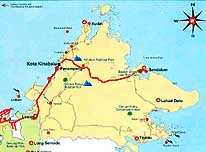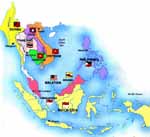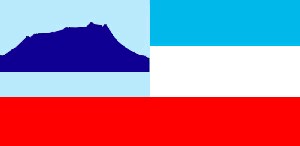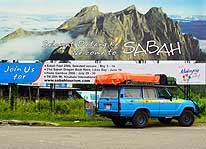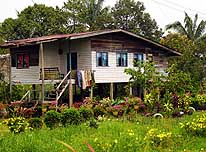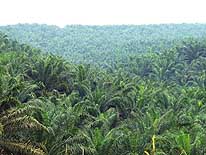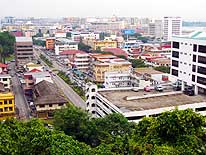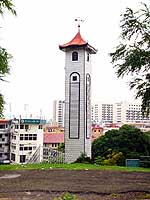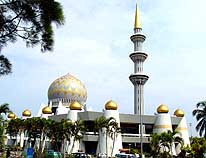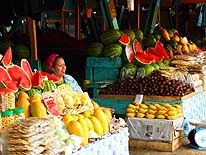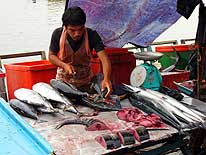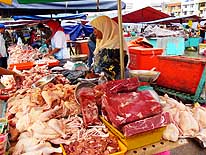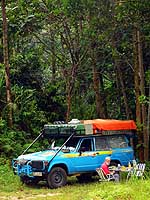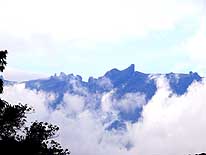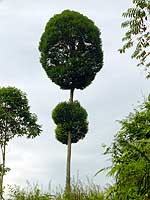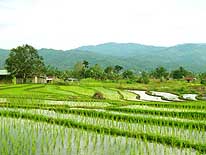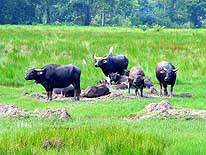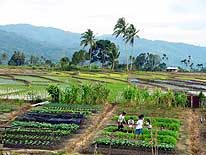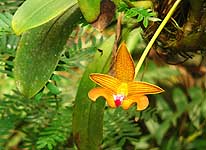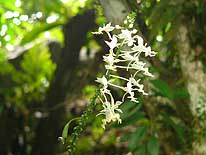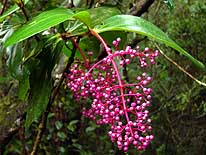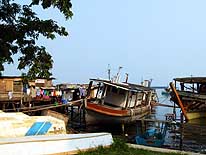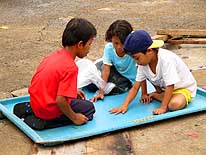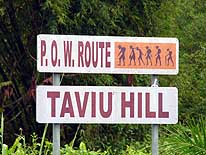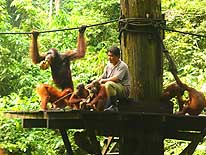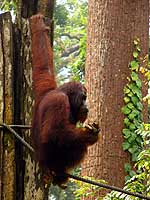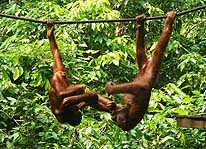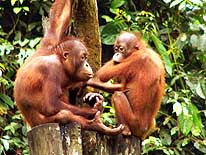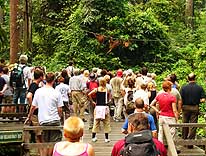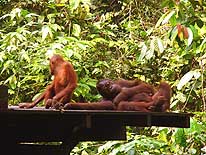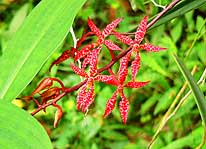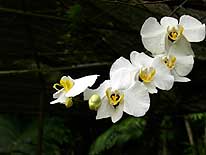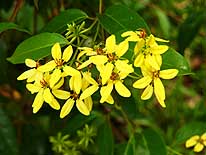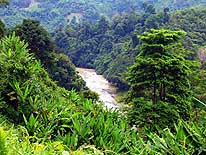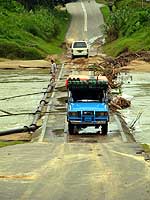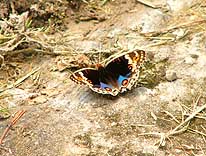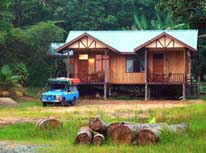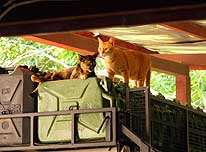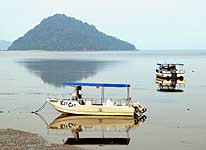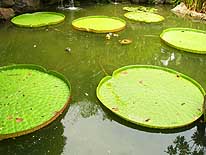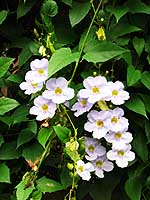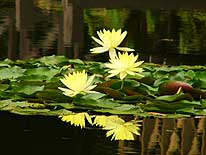- Enjoy some pictures of the worldrecordtour, taken in Sabah,
- the East Malaysian Province on Borneo
|
||||
Sabah
|
Malaysia
|
|||
More websites from Borneo:
|
||||
|
|
|
||
|
|
|
||
|
||||
|
|
|
||
| Thunder and lightening and lightening and thunder keep us awake the whole night. We hear the tropical rain pouring down on our corrugated iron roof. The strong swell of the sea is increasing hourly and soon it cannot be overheard anymore, when the high waves are breaking with a rumbling noise at the water edge – hopefully not a Tsunami? It is good to know that at least our faithful LandCruiser, whose windscreen is leaking considerably since its recent rejuvenation, is save this night under a well protecting roof. Were we still able to catch a glimpse of the small off shore islands last evening, today morning everything is hidden in an impenetrable grey wall of fog. Towards noon, when the sight improves a little bit, we continue our journey. But already reaching the first supermarket near town, a new violent tropical storm sweeps over the place, forcing us to look for shelter until the weather situation improves again. As it has happened many times before during our epic journey, we seek “refuge” at Mc Donald’s – present also here in different city corners – where a cheese burger is always enjoyable and where we spend some dry hours. Right opposite is a huge shopping mall with a cyber cafe, where we kill more precious time until towards the evening, the skies start to clear a little. Then, we stroll to the nearby water front, just in time to watch the beginning set-up of the colorful night market. Vegetables, fruits, fish, chicken – everything is carefully displayed and everything is available in excess. From the many arrays of lovely looking fruit pyramids, we buy the red fleshy mango that – beside the papaya – is our favorite tropical fruit. A big crowd of people gather around a small table with fish, where a huge specimen is hanging on a strong hook and where slice after slice is cut and sold. It must be either good value or a real delicacy. Knowing not much about fish, we cannot judge. In one corner, children sit on a huge, light blue tray, concentrating on a game with coins. Being an enthusiast of lively markets, I get never bored.
|
||||
|
|
|
||
| But at a certain moment, Emil pushes to change the scenario. We drive to the Signal Hill, enjoying from there a lovely view over the colorful roofs of KK in the evening light and visit afterwards the beautiful state mosque with its gold patterned dome, thus having already seen all the interesting sights of KK, Sabah’s capital and main city. For the night, we return to the “Seaside Travellers Inn”. Next morning, apart from the usual breakfast consisting of toast, butter and marmalade, there is additionally scrambled eggs and ham to choose. We find out that the reason is an Australian tourist group dressed adventurously in “khaki outfit”, which arrived late last night. This morning, the panorama from our veranda table is simply beautiful: The sun is out again and embraces the small off-shore islands, the sea is blue and quiet, and the wave splash softly on the shore. It is low tide. White egrets are searching motionless for food and reflect wonderfully in the shallow water – a wonderful sight, disturbed only by the loud conversations of the tour group that does not seem to have the same enthusiasm for this enchanting moment as we do. After Emil’s fourth coffee (usually he is happy with three!) he is ready to move on. We feel really sorry to bother the two sweet cats that chose to sleep already the second night on our LandCruiser’s jerry cans on the roof rack. The red one does not understand the world anymore as the car starts moving and it keeps its position for quite some time before realizing what happens. A hastily jump to safety brings it back to earth.
|
||||
|
|
|
||
| Before we leave the always congested KK, we investigate at the tourist office, the Nationalpark-Service and the forestry if a rare Rafflesia flower – the biggest in the world – is currently blooming. The answer is a real knock down. The flowering season here just finished at the end of September, we are told. “Come again next April!” Actually, this information is totally contrarily to all previous ones, which says that this wonderful, amazing flower can be seen all year round. But having no other reliable source left to inquire, we have to believe them. Not without frustration, we therefore erase already our first expectation of our Sabah trip. Afterwards we take a turn into the mountains. The road snakes its way nicely through jungle covered hills, giving now and then a glimpse of the hilly panorama, which unfortunately can be seen only partly, as the enormous clouds of smoke of the illegal slash-and-burn forest clearing, not only predominantly in neighboring Indonesia, have covered the sky. It happens every year, and every year nobody cares and does anything against it. October is said to be the worst month in this respect, and today we write October 5th! From the promising Mt. Kinabalu, there is no trace at all! It hides persistently behind a compact cap of clouds. Emil is really frustrated: The call of the mountains means so much more to him than a colorful market scene. To improve our kind of a downhill mood, we follow a small stony track leading uphill for a peaceful lunch, and we set up our camping gear. Soon, our newly discovered aperitif – a gin tonic –, followed by boiled eggs, cucumber and tomato salad and of course plenty of cheese – makes us feel much more relaxed, rounded up by dates and banana cake as desert, and certainly some beers are not to be missed. At first, we see only long, black ears, then a shy female dog lying down in a safe distance from us, but watching every of our movements attentively. It is always surprising how these visitors appear suddenly from out of nowhere. As soon as we get up and want to give her some food, she disappears as sudden as she appeared.
|
||||
|
|
|
||
| It is drizzling when we reach the Mt. Kinabalu-Nationalpark. As soon as we step out of our car, a stiff chilly wind blows into our face and we feel the cold penetrating right to our bones. It takes just minutes that our bare feet are hidden in warm socks and we look desperately for a warm jumper. What we are now longing for is a cup of hot, steaming coffee, while only a few hours earlier we were craving for an ice cold Coke. Writing my diary in the hotel, I have to cover my legs with the thin bed blanket. Yes, despite our firm desire to set up a camp under a clear sky at the foot of the mighty Mt. Kinabalu, we dismissed this idea rapidly and escaped into the “Kinabalu Rose Cabin Lodge”. Our room faces the mountain and has a small wooden porch. It does not last long before a violent storm howls across the place, rattling on doors and roofs. How very glad we are to be surrounded by four protective walls. We both sleep in the same narrow bed under two covers to keep each other warm. When I have to visit the bathroom, I automatically peek out of the window. But there is no change in the weather pattern. The thick mist still enters right our window. Not to miss any precious moment, we take our breakfast in front of the open veranda door next morning and trace the dark clouds drifting with great speed across the famous mountain. We feel like a cat sitting in front of a mouse hole. But the “mouse” shows its pointed ears only for seconds when the fog raises for an instant. Veils of mist start to rise everywhere from the densely forested mountain slopes, forming bizarre towers heading skywards. It is a constantly changing natural spectacle. When a new compact wall of fog approaches, we know that this was it! Additionally, it starts to rain, most heavily at 11am when we have to check out. The friendly owners of the lodge give us a full box of mineral water, two key hooks and a Mt. Kinabalu sticker – a lovely gesture for a few pictures shot hurriedly in the rain with our car in front of their mountain lodge. How many times did we already pose for pictures? We cannot remember, but certainly we would already have a nice figure if we got only a few coins each time. Therefore, we really appreciate the lovely gesture of the “Kinabalu Rose Cabin Lodge”.
|
||||
|
||||
| Driving down to the green Ranau valley in the heavy rain and omnipresent mist, we are not happy with the “weather god” at all, who deprived us of the so much hoped experience to camp in the nature and be greeted in the morning by a beautiful mountain scenery. Thus, within the first days, we already have to bury our second expectation put into Sabah. At least, we can book one success as we drive slowly through rainy Ranau: We discover a big Shell Station with a roofed lift, which even can raise our heavy LandCruiser what does not happen often. The timing is just right. After 600 miles since our first engine overhaul, we need to make an oil change – and up to now, we already drove 700 miles, because Emil is understandably not in a mood to crawl in the rain and mud under the car. In this country, it does not make sense anyway when the work costs merely RM8 = US$2. With this oil change, also our confidence into our LandCruiser’s robustness returns slowly again. The scenery gets more rural, as we drive up and down the hills towards the Eastern plains. Humble dwellings on stilts appear, with arrays of colorful clothes hung up to dry and exotic well-maintained flower-pots everywhere. Rice fields spread out below us in a lush green color. Now and then, we see local women pondering rice in front of their homes or walking with baskets strapped to their backs beside the street. A mighty jungle river snakes its way through a remaining part of the rainforest, before we reach the plains. It is the mighty river Sungai Liwagu that we follow for some time near Telupid. What comes after, destroys harshly another of our visions – already our third in Sabah: Palmoil plantations are reaching out infinitely ahead and beside us – for more than 70 miles. This robs us our very last illusion to still find some considerable stretches of an untouched jungle paradise. Since the price for a barrel of oil increased to about US$80, it is profitable to wipe out the existing rainforest to grow cheaper palm oil, which can be added to the fuel – a lucrative process with disastrous consequences. In Sepilok near Sandakan, only 15½ sq. miles could be protected to give the highly endangered ape, the Orang Utan, a chance to survive in a tiny sanctuary in some natural habitat – their own rainforest.
|
||||
|
|
|
||
| Next morning at 8.45am, when we arrive at the parking of the Rehabilitation Center, the place is already run over by buses and minibuses. In front of the ticketing office, visitors, who are willing to pay the relatively high entry fee of US$10, are already queuing up. This time, we do not regret one cent hoping that the money will help the Sanctuary to continue. The video being shown at 9am is very touching and it is impossible not to get involved emotionally, seeing the terrible destruction the human is capable to do in his aim to make still more profit. If the deforestation will not stop soon, these adorable human-like primates will have no chance to survive in the longer run. Some pessimists even prognostic that they might be extinct already in 15 to 20 years, because the palm oil barons will own by then also the last square feet of jungle. Orphans and Orang Utan that were kept as deplorable chained domestic animals and could be freed however, find a home in the rehabilitation center. In the “nursery”, they are raised and looked after with love – around the clock even if they still need to be fed by the bottle. The goal of this sanctuary is to learn them the skills to survive in the forest, which can take years. Deprived of their mothers, these youngsters have to learn everything necessary from the beginning for their jungle life: How to climb, how to swing across the trees, what fruits, tree barks, seeds and leafs are edible. Once they have achieved full independence, they become integrated into the Sepilok wild Orang Utan population. An integrated animal clinic guarantees their health and well-being. At playing time, the little ones are barreled around having a good time – it is absolutely adorable and heart refreshing.
|
||||
|
|
|
||
| A male reaches sexual maturity with 15, a female with 7 years. 60% of their daily activity is spent in searching for food. To be able to rest, they build a bed out of leafs high in the trees – each day a new one, preferably in branch forks. Time invested: A few minutes up to 20 minutes. All this information is obtainable from the richly illustrated and informative museum. A totally new and fascinating experience however is to be face to face with these intelligent primates in their natural habitat, the rainforest – for us our first impressive encounter. Their big brothers however – the African gorillas – are not anymore unknown to us. We tracked them down in Zaire, now named “Democratic Republic of Congo”, in August 1991 with a trekker, after many hours of an exhausting walk through deep jungle. Still we recall very well the moment when a big male suddenly made a frightening trick attack on Emil, who then rolled with his camera downhill, but luckily remained unhurt and the camera still working. At that time, it was definitely more adventure than today where we follow for 15 minutes a ranger with a crowd of other excited visitors to the feeding platform. But today, it is definitely more entertaining. We witness how more and more Orang Utan appear from the rainforest – at the end we count 10. They swing themselves with great agility and grace across the ropes leading to the feeding platform, where two rangers already are ready with a huge bowl of milk and plenty of bananas – two valuable supplements to their natural forest diet. Immediately “catch as catch can” starts. The first one to take its share is a strong male, who grabs three banana bunches at once, stuffing one in his mouth and pinching two more between his toes. Then he swings himself with great mobility to another tree, starts pealing bananas and demonstrates that he does not want to be disturbed anymore. He even turns demonstratively his back towards the spectators. In the meantime, also the shyer females and youngsters venture to get their portion. And below the platform and on an opposite tree grey long tail macaques wait for their appropriate moments as well. They are not so capable in balancing across the big rope as the Orang Utan with their extremely long arms and often lose their balance. It is heart-moving and we enjoy it fully, until also the last “wild man of Borneo” retreats into the forest. Only then, we walk back to the car park, already knowing that this encounter will always be something special to remember.
|
||||
|
|
|
||
| In front of our LandCruiser, a young couple is waiting for us. They introduce themselves as “Sid” and “Junky”, living in the United Arab Emirates and being on vacation here. Their enthusiasm can not be overlooked as they tell us that they know us already for quite a while from the website of the Dubai 4x4 Club, but they never would have expected to meet us one day somewhere personally. We have much to talk about and it does not last long that memories come up from lonely desert tours and traditional camel racing. “Dubai has grown a lot since and it became unfortunately very expensive too” they try to damp our inflamed enthusiasm a little. Nevertheless: We would not mind to visit this area anytime also for a fourth time, because the Arabian Peninsula still belongs to the regions we like the most. Long after we said good-bye to these two lovely young people, Arabia still continues to cross our mind. But after a while, we push aside our dreams and return to the present. Even if the final car papers for the Philippines are not ready yet, we decide to drive the 16 miles to Sandakan – Sabah’s port on the Sulu-Sea, where the car ferry is supposed to take us to Mindanao in the Southern Philippines – for the last necessary inquiries. In the early afternoon, we park right in front of the agent’s office – Timmarine at Jalan Leila 112. Already as we enter the office, people shake their heads. What does that mean? To our great surprise, we have to learn very soon that this car ferry does not run anymore, only a passenger ferry remains. This very moment, our whole house of cards collapses and somehow we are even a kind of “thankful” to the Philippine authorities who still delay our entry procedure. Otherwise we would now be confronted with a real problem. This is already our fourth dream we “lay to rest” in Sabah.
|
||||
|
||||
| And the fifth one follows straight away: We are told by the Office of Tourism, that our planned trip to Sukau (Kinabatangan river trip with a rich wild life like Proboscis monkeys) and Danum-Valley (with the almost last primary rainforest) is currently not possible due to blocked and flooded roads. The heavy tropical storms and rainfalls during the night, which also destroyed the viewing platform at the Orang Utan Rehabilitation Center, apparently affected the earth roads in such an extent that momentarily tourist- and 4x4-vehicles are still stuck and wait to be rescued. Sabah seems to shine under an unlucky star for us. And our next destination does not help to raise our spirit neither: We visit North Borneo’s “Sandakan Memorial Park”, built in honor of the Australian and English prisoners of war (POW) who lost their lives there in the Second World War. In a very painful way that touches us greatly, we read about the Japanese atrocities, which erased 2’700 people. Most POW’s were captured in Singapore and transferred to Sandakan after the capitulation of the Allied Forces and used as labor force to build a military airstrip. When this airstrip was bombed and destroyed by the Allied Forces in late 1944 while advancing in the Pacific, in early 1945 the Japanese decided to move the POW’s 165 miles west into the mountains to the small settlement of Ranau. On three forced marches between January and June approx. 500 prisoners died. The remainder died at the Ranau and Sandakan camps. Only six Australians escaped, assisted by local people. Illnesses, malnutrition, starvation, beating, punishment and overwork were the main causes of this tragedy. If somebody was too weak to follow, he got shot.
|
||||
|
|
|
||
| Today a beautiful green park with a lovely lily pond is on the site of the original PWO camp. A few remains of the earlier installations and war relicts used by the prisoners are still scattered around the place. Mid afternoon, we are glad to be back at our peaceful bungalow at the “Sepilok B&B Lodge”, where we booked for two nights a very newly built cabin, as the camping ground is still under construction and will probably be so for some more months to come. There are no other guests besides us. What we appreciate the most is to be surrounded by lush greenery and the quietness, especially in the morning at breakfast in the cozy restaurant of the lodge, accommodating only four tables. Besides coffee, toast, margarine, marmalade we also enjoy freshly picked bananas and papayas from their own garden. To our delight, the second morning about one dozen of the majestic hornbills make a short stop on a nearby high tree before flying away again – one after the other. The only person we encounter is Julia, a young Swiss lady, who is making her dissertation of Borneo’s rainforest. She plants trees and studies them under different conditions, speaking of generalists and specialists. She has to find out why the specialists are not able to thrust aside the generalists. We have an interesting conversation and admire the will of this young lady, who walks during any weather condition every morning into the deep jungle with her local helpers and accepts the hardship of unbearable heat, humidity and all kind of crawling and flying insects.
|
||||
|
|
|
||
| It is also Julia, who recommends us the “Rainforest Discovery Center”, which is very close to our “Sepilok B&B Lodge”. What we see exceeds by far our expectations. In a beautifully park setting with winding paths, small ponds and romantic bridges, we find a wonderful collection of exotic flowers, plants, trees and bushes. Especially striking is the variety of distinctive orchids in full bloom. Each one gives its special color, form and grace to this place. Special are also the dark green, fleshy lily stems, which can reach a proud diameter of a yard – a very impressive size. Again and again we are amazed about the beauty nature is able to produce! This luxury tropical garden is our last discovery in Sabah. Next morning, we backtrack to Sarawak – leaving behind us a Mt. Kinabalu still heavily shrouded in clouds and the disturbing endless palm oil plantations. Have our Sabah expectations been fulfilled? Unfortunately, we have to answer with a clear No – partly also due to ongoing bad weather conditions. But our biggest disappointment is that all our hopes and illusions to find still some sizeable remnants of virgin jungle in this Northern corner of Borneo, have been destroyed. When we say good-bye to Sabah after only ten days, we cannot help to recall a sign along the road, which we saw in the year 2000 during our second West-East-crossing of the United States: “Our power to destroy surpasses the earth’s power to restore!”
|
||||
|
||||
More websites from East Malaysia and Brunei:
|
||||
